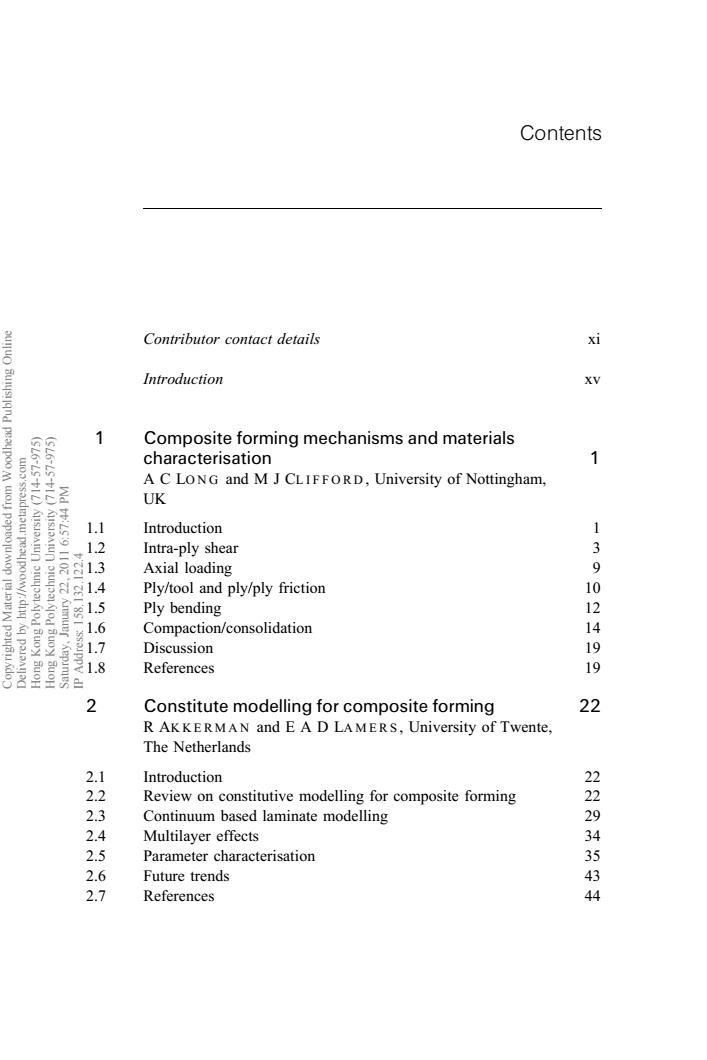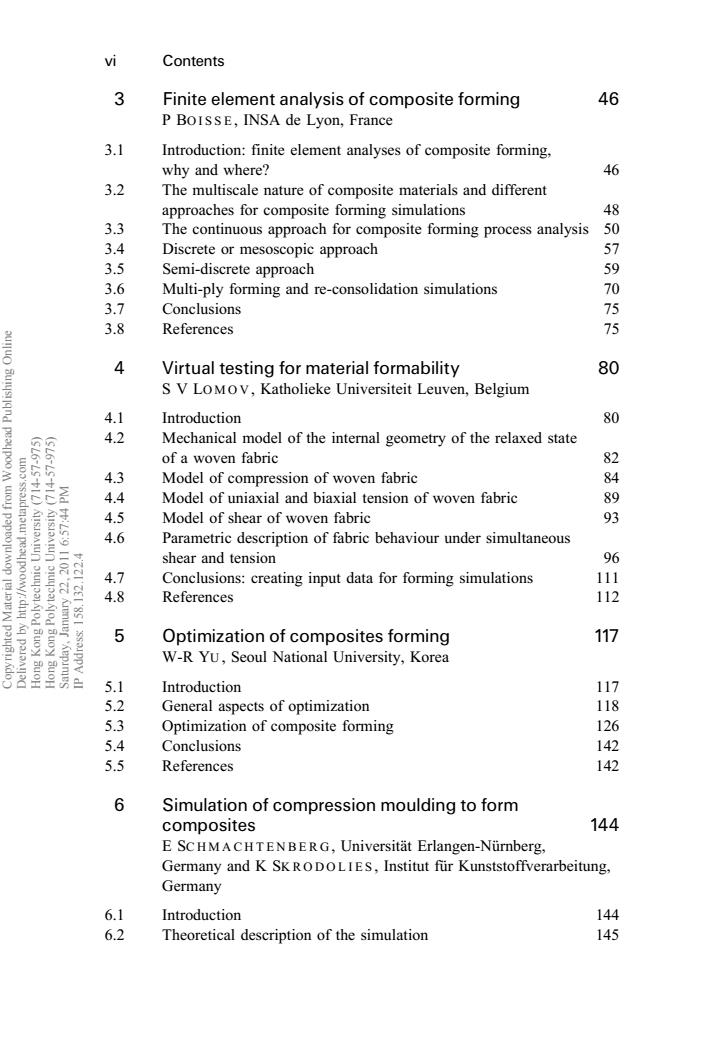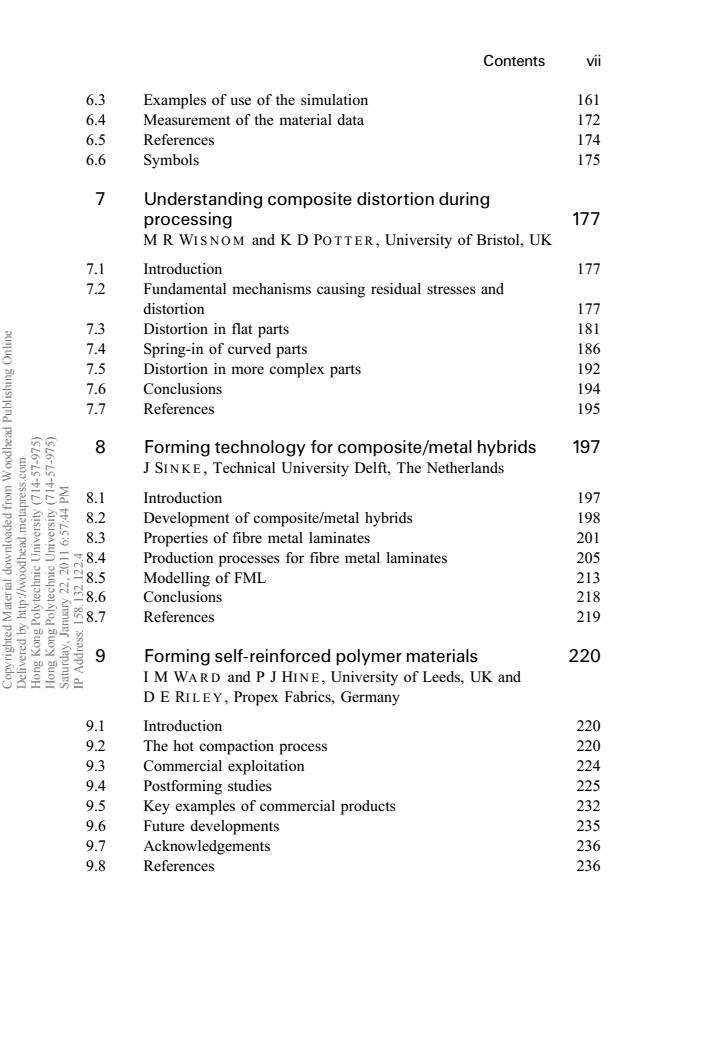
Composites forming technologies Edited by A.C.Long woo'ssadmaur'peaypoowy/:dny q paianad Wd tt:Ls:9 I10Z'ZZ ZZI'ZEI '8S[ssauppv dl The Textile Institute CRC CRC Press Boca Raton Boston New York Washington,DC WOODHEAD PUBLISHING LIMITED Cambridge England
Composites forming technologies Edited by A. C. Long Copyrighted Material downloaded from Woodhead Publishing Online Delivered by http://woodhead.metapress.com Hong Kong Polytechnic University (714-57-975) Hong Kong Polytechnic University (714-57-975) Saturday, January 22, 2011 6:57:44 PM IP Address: 158.132.122.4

Contents Contributor contact details xi Introduction 1 Composite forming mechanisms and materials 826-75110 characterisation 1 A C LONG and M J CLIFFORD,University of Nottingham, woo'ssaidmaur'peaypoow/:dny Aq paianad UK Wd t:Ls:9 I10Z'Z 1.1 Introduction 1 1.2 Intra-ply shear 3 Axial loading 9 Ply/tool and ply/ply friction 10 .5 Ply bending 12 16 Compaction/consolidation 14 1 Discussion 19 References 2 Constitute modelling for composite forming 22 R AKKERMAN and E A D LAMERS,University of Twente, The Netherlands 2.1 Introduction 2.2 Review on constitutive modelling for composite forming 2.3 Continuum based laminate modelling 2.4 Multilayer effects 2.5 Parameter characterisation 222945 2.6 Future trends 2.7 References 44
Contributor contact details xi Introduction xv 1 Composite forming mechanisms and materials characterisation 1 ACLONG and M J CLIFFORD , University of Nottingham, UK 1.1 Introduction 1 1.2 Intra-ply shear 3 1.3 Axial loading 9 1.4 Ply/tool and ply/ply friction 10 1.5 Ply bending 12 1.6 Compaction/consolidation 14 1.7 Discussion 19 1.8 References 19 2 Constitute modelling for composite forming 22 R AKKERMAN and E A D LAMERS , University of Twente, The Netherlands 2.1 Introduction 22 2.2 Review on constitutive modelling for composite forming 22 2.3 Continuum based laminate modelling 29 2.4 Multilayer effects 34 2.5 Parameter characterisation 35 2.6 Future trends 43 2.7 References 44 Contents Copyrighted Material downloaded from Woodhead Publishing Online Delivered by http://woodhead.metapress.com Hong Kong Polytechnic University (714-57-975) Hong Kong Polytechnic University (714-57-975) Saturday, January 22, 2011 6:57:44 PM IP Address: 158.132.122.4

vi Contents 3 Finite element analysis of composite forming 46 P BOISSE,INSA de Lyon,France 3.1 Introduction:finite element analyses of composite forming, why and where? 46 3.2 The multiscale nature of composite materials and different approaches for composite forming simulations 48 3.3 The continuous approach for composite forming process analysis 50 3.4 Discrete or mesoscopic approach 57 3.5 Semi-discrete approach 59 3.6 Multi-ply forming and re-consolidation simulations 70 3.7 Conclusions 75 3.8 References 75 4 Virtual testing for material formability 80 Sunysijqnd S V LOMOV,Katholieke Universiteit Leuven,Belgium 4.1 Introduction 80 4.2 Mechanical model of the internal geometry of the relaxed state 82 wos' of a woven fabric 4.3 Model of compression of woven fabric 84 4.4 Model of uniaxial and biaxial tension of woven fabric 89 'ssaudmau'peaypoow/: 4.5 Model of shear of woven fabric 93 4.6 Parametric description of fabric behaviour under simultaneous shear and tension 96 02. 到 4.7 Conclusions:creating input data for forming simulations 111 4.8 References 112 5 Optimization of composites forming 117 W-R YU,Seoul National University,Korea 5.1 Introduction 117 5.2 General aspects of optimization 118 5.3 Optimization of composite forming 126 5.4 Conclusions 142 5.5 References 142 6 Simulation of compression moulding to form composites 144 E SCHMA CHTEN BERG,Universitat Erlangen-Nurnberg, Germany and K SK RODOLIES,Institut fur Kunststoffverarbeitung, Germany 6.1 Introduction 144 6.2 Theoretical description of the simulation 145
3 Finite element analysis of composite forming 46 P BO I S S E , INSA de Lyon, France 3.1 Introduction: finite element analyses of composite forming, why and where? 46 3.2 The multiscale nature of composite materials and different approaches for composite forming simulations 48 3.3 The continuous approach for composite forming process analysis 50 3.4 Discrete or mesoscopic approach 57 3.5 Semi-discrete approach 59 3.6 Multi-ply forming and re-consolidation simulations 70 3.7 Conclusions 75 3.8 References 75 4 Virtual testing for material formability 80 S V LO M O V , Katholieke Universiteit Leuven, Belgium 4.1 Introduction 80 4.2 Mechanical model of the internal geometry of the relaxed state of a woven fabric 82 4.3 Model of compression of woven fabric 84 4.4 Model of uniaxial and biaxial tension of woven fabric 89 4.5 Model of shear of woven fabric 93 4.6 Parametric description of fabric behaviour under simultaneous shear and tension 96 4.7 Conclusions: creating input data for forming simulations 111 4.8 References 112 5 Optimization of composites forming 117 W-R YU , Seoul National University, Korea 5.1 Introduction 117 5.2 General aspects of optimization 118 5.3 Optimization of composite forming 126 5.4 Conclusions 142 5.5 References 142 6 Simulation of compression moulding to form composites 144 E SC H M A C H T E N B E R G , UniversitaÈt Erlangen-NuÈrnberg, Germany and K SK R O D O L I E S , Institut fuÈr Kunststoffverarbeitung, Germany 6.1 Introduction 144 6.2 Theoretical description of the simulation 145 vi Contents Copyrighted Material downloaded from Woodhead Publishing Online Delivered by http://woodhead.metapress.com Hong Kong Polytechnic University (714-57-975) Hong Kong Polytechnic University (714-57-975) Saturday, January 22, 2011 6:57:44 PM IP Address: 158.132.122.4

Contents vii 6.3 Examples of use of the simulation 161 6.4 Measurement of the material data 172 6.5 References 174 6.6 Symbols 175 7 Understanding composite distortion during processing 177 M R WIS NOM and K D POTTER,University of Bristol,UK 7.1 Introduction 177 7.2 Fundamental mechanisms causing residual stresses and distortion 177 7.3 Distortion in flat parts 181 7.4 Spring-in of curved parts 186 7.5 Distortion in more complex parts 192 Suysijqnd peaupoo M 7.6 Conclusions 194 7.7 References 195 8 Forming technology for composite/metal hybrids 197 J SINKE,Technical University Delft,The Netherlands woo'ssaudmaur'peaqpoowy/dg 1876-5 8.1 Introduction 197 12.9102. 8.2 Development of composite/metal hybrids 198 8.3 Properties of fibre metal laminates 201 Production processes for fibre metal laminates 205 8.5 Modelling of FML 213 8.6 Conclusions 218 8.7 References 219 9 Forming self-reinforced polymer materials 220 I M WARD and P J HINE,University of Leeds,UK and D E RILEY,Propex Fabrics,Germany 9.1 Introduction 220 9.2 The hot compaction process 220 9.3 Commercial exploitation 224 9.4 Postforming studies 225 9.5 Key examples of commercial products 232 9.6 Future developments 235 9.7 Acknowledgements 236 9.8 References 236
6.3 Examples of use of the simulation 161 6.4 Measurement of the material data 172 6.5 References 174 6.6 Symbols 175 7 Understanding composite distortion during processing 177 M R WI S N O M and K D PO T T E R , University of Bristol, UK 7.1 Introduction 177 7.2 Fundamental mechanisms causing residual stresses and distortion 177 7.3 Distortion in flat parts 181 7.4 Spring-in of curved parts 186 7.5 Distortion in more complex parts 192 7.6 Conclusions 194 7.7 References 195 8 Forming technology for composite/metal hybrids 197 J SI N K E , Technical University Delft, The Netherlands 8.1 Introduction 197 8.2 Development of composite/metal hybrids 198 8.3 Properties of fibre metal laminates 201 8.4 Production processes for fibre metal laminates 205 8.5 Modelling of FML 213 8.6 Conclusions 218 8.7 References 219 9 Forming self-reinforced polymer materials 220 I M WA R D and P J HI N E , University of Leeds, UK and D E RI L E Y , Propex Fabrics, Germany 9.1 Introduction 220 9.2 The hot compaction process 220 9.3 Commercial exploitation 224 9.4 Postforming studies 225 9.5 Key examples of commercial products 232 9.6 Future developments 235 9.7 Acknowledgements 236 9.8 References 236 Contents vii Copyrighted Material downloaded from Woodhead Publishing Online Delivered by http://woodhead.metapress.com Hong Kong Polytechnic University (714-57-975) Hong Kong Polytechnic University (714-57-975) Saturday, January 22, 2011 6:57:44 PM IP Address: 158.132.122.4

viⅷ Contents 10 Forming technology for thermoset composites 239 R PATON,Cooperative Research Centre for Advanced Composite Structures Ltd,Australia 10.1 Introduction 239 10.2 Practicalities of forming thermoset prepeg stacks 240 10.3 Deformation mechanisms in woven fabric prepeg 241 10.4 Tape prepreg 247 10.5 Forming processes 248 10.6 Tooling equipment 250 10.7 Diaphagm forming tooling 251 10.8 Potential problems 252 10.9 Process capabilities 253 10.10 Future trends 253 10.11 References 254 Sunysijqnd 11 Forming technology for thermoplastic composites 256 R BROOKS,University of Nottingham,UK 1876-55 11.1 Introduction 256 11.2 Thermoplastic composite materials(TPCs)for forming 256 woo'ssaudmaur'peaypoowy/:dy 11.3 Basic principles of TPC forming technologies 262 11.4 Forming methods 264 11.5 Some recent developments 273 11.6 Conclusions 275 11.7 References 275 12 The use of draping simulation in composite design 277 J W KLINTWORTH,MSC Software Ltd,UK and A C LONG,University of Nottingham,UK 12.1 Introduction 277 12.2 Zone and ply descriptions 277 12.3 Composites development process 278 12.4 Composites data exchange 281 12.5 Draping and forming simulation 282 12.6 Linking forming simulation to component design analysis 284 12.7 Conclusions 291 12.8 References 292
10 Forming technology for thermoset composites 239 R PA T O N , Cooperative Research Centre for Advanced Composite Structures Ltd, Australia 10.1 Introduction 239 10.2 Practicalities of forming thermoset prepeg stacks 240 10.3 Deformation mechanisms in woven fabric prepeg 241 10.4 Tape prepreg 247 10.5 Forming processes 248 10.6 Tooling equipment 250 10.7 Diaphagm forming tooling 251 10.8 Potential problems 252 10.9 Process capabilities 253 10.10 Future trends 253 10.11 References 254 11 Forming technology for thermoplastic composites 256 R BR O O K S , University of Nottingham, UK 11.1 Introduction 256 11.2 Thermoplastic composite materials (TPCs) for forming 256 11.3 Basic principles of TPC forming technologies 262 11.4 Forming methods 264 11.5 Some recent developments 273 11.6 Conclusions 275 11.7 References 275 12 The use of draping simulation in composite design 277 J W KL I N T W O R T H , MSC Software Ltd, UK and A C LO N G , University of Nottingham, UK 12.1 Introduction 277 12.2 Zone and ply descriptions 277 12.3 Composites development process 278 12.4 Composites data exchange 281 12.5 Draping and forming simulation 282 12.6 Linking forming simulation to component design analysis 284 12.7 Conclusions 291 12.8 References 292 viii Contents Copyrighted Material downloaded from Woodhead Publishing Online Delivered by http://woodhead.metapress.com Hong Kong Polytechnic University (714-57-975) Hong Kong Polytechnic University (714-57-975) Saturday, January 22, 2011 6:57:44 PM IP Address: 158.132.122.4